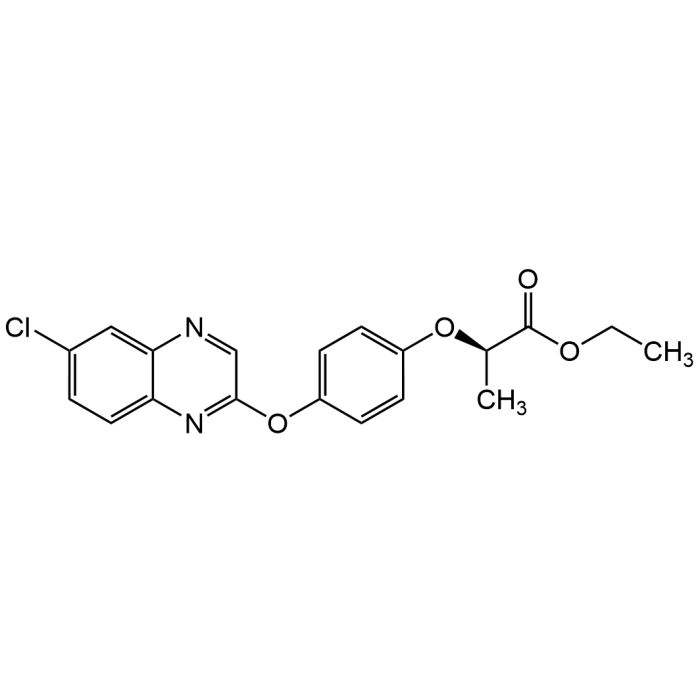Cookie Policy: This site uses cookies to improve your experience. You can find out more about our use of cookies in our Privacy Policy. By continuing to browse this site you agree to our use of cookies.
Chemodex
Quizalofop-p-ethyl

| Product Details | |
|---|---|
| Synonyms | Quinofop-ethyl; DPX-Y6202; Ethyl (R)-2-[4-(6-chloro-2-quinoxalyloxy)phenoxy]propionate |
| Product Type | Chemical |
| Properties | |
| Formula | C19H17ClN2O4 |
| MW | 372.8 |
| CAS | 100646-51-3 |
| Source/Host Chemicals | Synthetic |
| Purity Chemicals | ≥98% |
| Appearance | White to light yellow powder. |
| Solubility | Soluble in DMSO (20mg/ml) or methanol. |
| Identity | Determined by 1H-NMR. |
| Declaration | Manufactured by Chemodex. |
| Other Product Data |
Click here for Original Manufacturer Product Datasheet |
| InChi Key | OSUHJPCHFDQAIT-GFCCVEGCSA-N |
| Smiles | O=C([C@@H](C)OC1=CC=C(C=C1)OC2=NC3=CC=C(C=C3N=C2)Cl)OCC |
| Shipping and Handling | |
| Shipping | AMBIENT |
| Short Term Storage | +4°C |
| Long Term Storage | -20°C |
| Handling Advice | Protect from light and moisture. |
| Use/Stability | Stable for at least 2 years after receipt when stored at -20°C. |
| Documents | |
| Product Specification Sheet | |
| Datasheet |
 Download PDF Download PDF |
Quizalofop-p-ethyl is a post-emergence herbicide that finds applications in annual and perennial weed control management. Quizalofop-p-ethyl acts as a selective post-emergence herbicide that targets the enzyme acetyl-CoA carboxylase (ACC), for fatty acid synthesis in plants. Consequently, Quizalofop-p-ethyl effectively disrupts lipid biosynthesis, leading to the cessation of growth and eventually the death of susceptible grassy weeds. Compound can be used as analytical reference material.
(1) M. Hamberg & Y.-L. Zhang; Anal. Biochem. 229, 336 (1995) | (2) J. Chen, et al.; Pestic. Biochem. Physiol. 176, 104862 (2021) | (3) A. Zaouak, A., et al.; Environ. Technol. 43, 4147 (2022) | (4) L. Zhu, et al.; Ecotoxicol. Environ. Saf. 238, 113596 (2022) | (5) S. Ferguson, et al.; Toxics. 10, 711 (2022) | (6) X. Liu, et al.; Sci. Total Environ. 857, 159427 (2023) | (7) V.H.V. Ribeiro, et al.; Pest Manag. Sci. 79, 4025 (2023)





